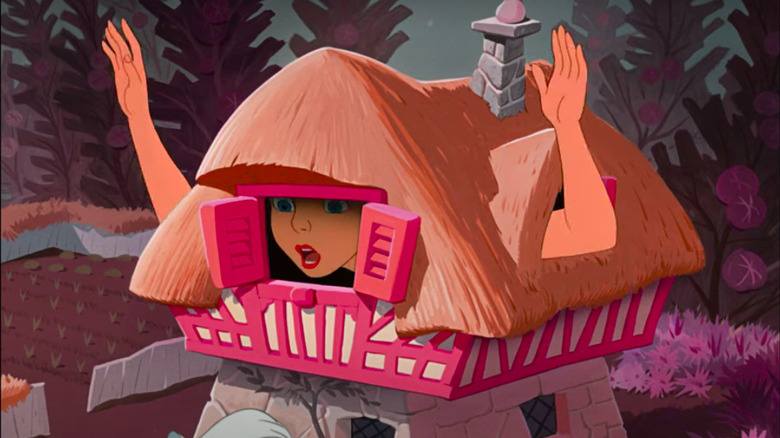Why Disney's Alice In Wonderland Didn't Find Success Until The '70s
Walt Disney's adaptation of Lewis Carroll's famous book, "Alice's Adventures in Wonderland," is now considered to be a beloved Disney classic. It stands out amongst the multitude of other Disney films with its trippy visuals and seeming lack of a "princess meets a prince" story. All it depicts is the story of Alice, a young girl who finds herself tumbling headlong into the world of Wonderland with not much of a choice in the mad hatter — I mean "matter." It's a wild romp of color and curiosity, and many consider it to be one of Disney's greatest films. However, this was not always the case.
When the film came out in 1951, it was met with terrible animosity. So much so that it didn't have its official theatrical debut until 23 years later (as noted by The Take), well after Walt Disney himself had passed away. Up until that point, the movie could only be seen on television from time to time. In America, people did not take well to Alice's story, but those living in the U.K. were just as upset by Disney's portrayal of Carroll's work. Clearly, Disney had a tough time convincing audiences that his version of the classic story was worthwhile, and it wasn't until after his death that people began to embrace his film.
It took a long time for Disney's "Alice in Wonderland" to get the recognition it deserves, and the reasons for its initial lack of success get curiouser and curiouser by the minute.
Adaptation and animation woes
It's true that Disney's version of "Alice's Adventures in Wonderland" is not a faithful adaptation of Lewis Carroll's book. In fact, it's actually a combination of both the first book in the Alice series and its sequel "Through the Looking Glass," with occasional changes and additions made to the story. Many people felt the choice to combine Carroll's two tales did nothing to enhance the story. Ironically, though, it seems that Disney himself was trying to actively avoid a perfect adaptation of the original source material. During one point in the writing process, Disney asked the famous author, Aldous Huxley to take a crack at the script. When Huxley delivered something that was too faithful to Carroll's work, Disney was disappointed, ultimately nixing all of Huxley's work on the potential script. Eventually, a script was written, but gone was the faithfulness to the original source material, a choice that would lead many U.K. viewers to declare the film too American for their tastes.
The other issue audiences had with "Alice in Wonderland" was the animation. Carroll's book is so closely tied to the work of John Tenniel who supplied the now-iconic illustrations, that audiences balked at the film's colorful, cartoonish renderings of Wonderland. However, this shift in visual tone seems to be on purpose. Disney felt some of the original storyboards for the film looked too much like Tenniel's work. He knew that imagery closely associated to the book's original illustrations was going to be difficult to animate, so he set about trying to find a new look. What he eventually landed on was inspired by storyboards done by Mary Blair, a decision that would ultimately make audiences cringe even if it's well-liked today.
The problem with Alice
Another major issue audiences had with Disney's adaptation was with Alice herself. Unlike the other Disney princesses before her, Alice seemed to have no real purpose (even if that purpose is simply to be a damsel in distress). People saw her as lacking ambition and drive, a lazy girl who daydreamed during her studies and wandered into a magical world.
The Take describes "Alice [as] a passive character who does what the various inhabitants of Wonderland instruct. This truth posed a challenge in rendering the character on screen, as she has little to identify with in terms of heroism or personality." In an article for The Talon, author Bruna Piccin postulates that the aftermath of World War II contributed to the dislike of Alice, writing, "Parents wanted movies with clear plots and morals to show their children, something that "Alice in Wonderland" lacked." Ultimately, Alice's passivity would be her downfall outside of Wonderland, making her hard to revere and even harder to accept into the hearts of viewers. It's a harsh opinion to have of one of the most celebrated characters in literature and film, but at the time, Alice was just not what the people wanted.
A psychedelic resurgence
Thankfully, "Alice in Wonderland" would finally see its day in the spotlight, and that spotlight came in the form of the drug-infused, psychedelic craze of the late '60s. It turns out that the film is exactly what hippies were looking for when searching for a movie to watch. "Alice in Wonderland" had everything from a trippy disappearing cat to a hookah smoking worm to flamingos being used as croquet sticks. It was a completely wild viewing experience, the perfect blend of curiosity and madness that fueled a good LSD high. The Take describes it "as a 'head film,' reflective of the drug culture of the generation," and even today, the movie is often seen as a symbol for drugs and psychedelia.
Whether Disney intended for his take on Alice's story to be synonymously linked to drug culture, remains to be seen. But there's no doubt that his vision for the film was way ahead of its time. One thing is certain though. Disney himself was not pleased with the film's final results. We'll never know if this is because Disney never got to see the film finally find success, or if he truly believed the movie wasn't very good. Either way, the movie eventually found its fans, and those who love it are all a little mad for doing so, which is exactly what Wonderland would want.



